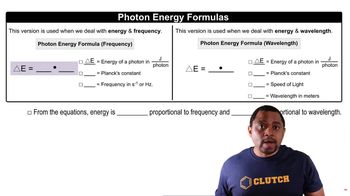(a) A green laser pointer emits light with a wavelength of 532 nm. What is the frequency of this light?
(a) Calculate and compare the energy of a photon with a wavelength of 3.0 mm to that of a photon with a wavelength of 0.3 nm.
 Verified step by step guidance
Verified step by step guidanceKey Concepts
Photon Energy

Wavelength and Frequency Relationship

Units of Measurement

(b) What is the energy of one of these photons?
(c) The laser pointer emits light because electrons in the material are excited (by a battery) from their ground state to an upper excited state. When the electrons return to the ground state, they lose the excess energy in the form of 532-nm photons. What is the energy gap between the ground state and excited state in the laser material?
An AM radio station broadcasts at 1000 kHz and its FM partner broadcasts at 100 MHz. Calculate and compare the energy of the photons emitted by these two radio stations.
One type of sunburn occurs on exposure to UV light of wavelength in the vicinity of 325 nm. (a) What is the energy of a photon of this wavelength?
One type of sunburn occurs on exposure to UV light of wavelength in the vicinity of 325 nm. (b) What is the energy of a mole of these photons?
